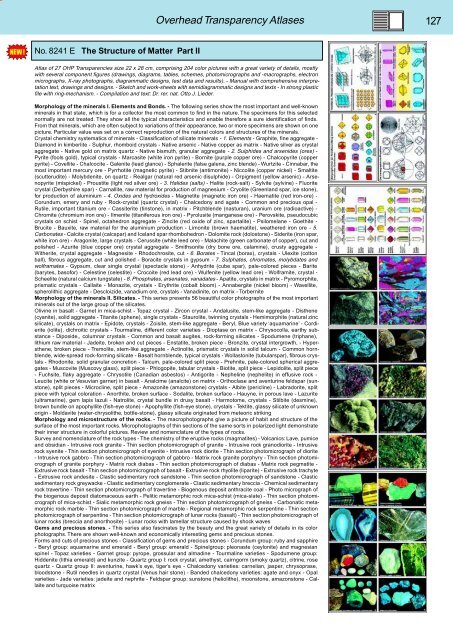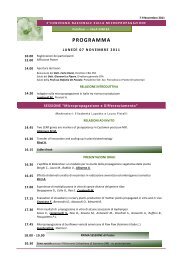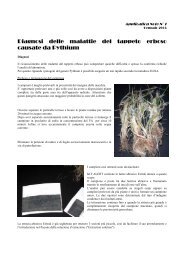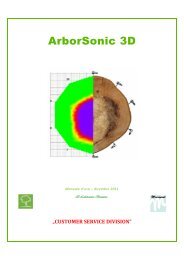BIOLOGY - microscopia.info
BIOLOGY - microscopia.info
BIOLOGY - microscopia.info
You also want an ePaper? Increase the reach of your titles
YUMPU automatically turns print PDFs into web optimized ePapers that Google loves.
Overhead Transparency Atlases<br />
127<br />
No. 8241 E The Structure of Matter Part II<br />
Atlas of 27 OHP Transparencies size 22 x 28 cm, comprising 204 color pictures with a great variety of details, mostly<br />
with several component figures (drawings, diagrams, tables, schemes, photomicrographs and -macrographs, electron<br />
micrographs, X-ray photographs, diagrammatic designs, test data and results). - Manual with comprehensive interpretation<br />
text, drawings and designs. - Sketch and work-sheets with semidiagrammatic designs and texts - In strong plastic<br />
file with ring-mechanism. - Compilation and text: Dr. rer. nat. Otto J. Lieder.<br />
Morphology of the minerals I. Elements and Bonds. - The following series show the most important and well-known<br />
minerals in that state, which is for a collector the most common to find in the nature. The specimens for this selected<br />
normally are not treated. They show all the typical characteristics and enable therefore a sure identification of finds.<br />
From that minerals, which are often subject to variations of their appearance, two or more specimens are shown on one<br />
picture. Particular value was set on a correct reproduction of the natural colors and structures of the minerals.<br />
Crystal chemistry systematics of minerals - Classification of silicate minerals - 1. Elements - Graphite, fine aggregate -<br />
Diamond in kimberlite - Sulphur, rhomboid crystals - Native arsenic - Native copper as matrix - Native silver as crystal<br />
aggregate - Native gold on matrix quartz - Native bismuth, granular aggregate - 2. Sulphides and arsenides (ores) -<br />
Pyrite (fools gold), typical crystals - Marcasite (white iron pyrite) - Bornite (purple copper ore) - Chalcopyrite (copper<br />
pyrite) - Covellite - Chalcocite - Galenite (lead glance) - Sphalerite (false galena, zinc blende) - Wurtzite - Cinnabar, the<br />
most important mercury ore - Pyrrhotite (magnetic pyrite) - Stibnite (antimonite) - Niccolite (copper nickel) - Smaltite<br />
(scutterudite) - Molybdenite, on quartz - Realgar (natural red arsenic disulphide) - Orpigment (yellow arsenic) - Arsenopyrite<br />
(mispickel) - Proustite (light red silver ore) - 3. Halides (salts) - Halite (rock-salt) - Sylvite (sylvine) - Fluorite<br />
crystal (Derbyshire spar) - Carnallite, raw material for production of magnesium - Cryolite (Greenland spar, ice stone),<br />
for production of aluminium - 4. Oxides and hydroxides - Magnetite (magnetic iron ore) - Haematite (red iron-ore) -<br />
Corundum, emery and ruby - Rock-crystal (quartz crystal) - Chalcedony and agate - Common and precious opal -<br />
Rutile, important titanium ore - Cassiterite (tinstone), in matrix - Pitchblende (nasturan), uranium ore (radioactive) -<br />
Chromite (chromium iron ore) - Ilmenite (titaniferous iron ore) - Pyrolusite (manganese ore) - Perovskite, pseudocubic<br />
crystals on schist - Spinel, octahedron aggregate - Zincite (red oxide of zinc, spartalite) - Psilomelane - Goethite -<br />
Brucite - Bauxite, raw material for the aluminium production - Limonite (brown haematite), weathered iron ore - 5.<br />
Carbonates - Calcite crystal (calcspar) and Iceland spar rhombohedron - Dolomite rock (dolostone) - Siderite (iron spar,<br />
white iron ore) - Aragonite, large crystals - Cerussite (white leed ore) - Malachite (green carbonate of copper), cut and<br />
polished - Azurite (blue copper ore) crystal aggregate - Smithsonite (dry bone ore, calamine), crusty aggregate -<br />
Witherite, crystal aggregate - Magnesite - Rhodochrosite, cut - 6. Borates - Tincal (borax), crystals - Ulexite (cotton<br />
ball), fibrous aggregate, cut and polished - Boracite crystals in gypsum - 7. Sulphates, chromates, molybdates and<br />
wolframates - Gypsum, clear single crystal (spectacle stone) - Anhydrite (cube spar), pale-colored pieces - Barite<br />
(barytes, basofor) - Celestine (celestite) - Crocoite (red lead ore) - Wulfenite (yellow lead ore) - Wolframite, crystal -<br />
Scheelite (natural calcium tungstate) - 8. Phosphates, arsenates, vanadates - Apatite, crystals in matrix - Pyromorphite,<br />
prismatic crystals - Callaite - Monazite, crystals - Erythrite (cobalt bloom) - Annabergite (nickel bloom) - Wavellite,<br />
spherolithic aggregate - Descloizide, vanadium ore, crystals - Vanadinite, on matrix - Torbernite<br />
Morphology of the minerals II. Silicates. - This series presents 56 beautiful color photographs of the most important<br />
minerals out of the large group of the silicates.<br />
Olivine in basalt - Garnet in mica-schist - Topaz crystal - Zircon crystal - Andalusite, stem-like aggregate - Disthene<br />
(cyanite), solid aggregate - Titanite (sphene), single crystals - Staurolite, twinning crystals - Hemimorphite (natural zinc<br />
silicate), crystals on matrix - Epidote, crystals - Zoisite, stem-like aggregate - Beryl, Blue variety ‘aquamarine’ - Cordierite<br />
(iolite), dichroitic crystals - Tourmaline, different color varieties - Dioptase on matrix - Chrysocolla, earthy substance<br />
- Diposide,, columnar crystals - Common and basalt augites, rock-forming silicates - Spodumene (triphane),<br />
lithium raw material - Jadeite, broken and cut pieces - Enstatite, broken piece - Bronzite, crystal intergrowth, - Hypersthene,<br />
broken piece - Tremolite, stem-like aggregate - Actinolite, prismatic crystals in solid talcum - Common hornblende,<br />
wide-spread rock-forming silicate - Basalt hornblende, typical crystals - Wollastonite (tubularspar), fibrous crystals<br />
- Rhodonite, solid granular concretion - Talcum, pale-colored split piece - Prehnite, pale-colored spherical aggregates<br />
- Muscovite (Muscovy glass), split piece - Phlogopite, tabular crystals - Biotite, split piece - Lepidolite, split piece<br />
- Fuchsite, flaky aggregate - Chrysotile (Canadian asbestos) - Antigorite - Nepheline (nephelite) in effusive rock -<br />
Leucite (white or Vesuvian garner) in basalt - Analcime (analcite) on matrix - Orthoclase and aventurine feldspar (sunstone),<br />
split pieces - Microcline, split piece - Amazonite (amazonstone) crystals - Albite (pericline) - Labradorite, split<br />
piece with typical coloration - Anorthite, broken surface - Sodalite, broken surface - Hauyne, in porous lave - Lazurite<br />
(ultramarine), gem lapis lazuli - Natrolite, crystal bundle in drusy basalt - Harmotome, crystals - Stilbite (desmine),<br />
brown bundle on apophyllite (fish-eye stone) - Apophyllite (fish-eye stone), crystals - Tektite, glassy silicate of unknown<br />
origin - Moldavite (water-chrysolithe, bottle-stone), glassy silicate originated from meteoric striking<br />
Morphology and microstructure of the rocks. - The macrophotographs give a picture of habit and structure of the<br />
surface of the most important rocks. Microphotographs of thin sections of the same sorts in polarized light demonstrate<br />
their inner structure in colorful pictures. Review and nomenclature of the types of rocks.<br />
Survey and nomenclature of the rock types - The chemistry of the eruptive rocks (magmatites) - Volcanics: Lave, pumice<br />
and obsidian - Intrusive rock granite - Thin section photomicrograph of granite - Intrusive rock granodiorite - Intrusive<br />
rock syenite - Thin section photomicrograph of syenite - Intrusive rock diorite - Thin section photomicrograph of diorite<br />
- Intrusive rock gabbro - Thin section photomicrograph of gabbro - Matrix rock granite porphyry - Thin section photomicrograph<br />
of granite porphyry - Matrix rock diabas - Thin section photomicrograph of diabas - Matrix rock pegmatite -<br />
Extrusive rock basalt - Thin section photomicrograph of basalt - Extrusive rock rhyolite (liparite) - Extrusive rock trachyte<br />
- Extrusive rock andesite - Clastic sedimentary rock sandstone - Thin section photomicrograph of sandstone - Clastic<br />
sedimentary rock greywacke - Clastic sedimentary conglomerate - Clastic sedimentary breccia - Chemical sedimentary<br />
rock travertine - Thin section photomicrograph of travertine - Biogenous deposit anthracite coal - Photo micrograph of<br />
the biogenous deposit diatomaceous earth - Pelitic metamorphic rock mica-schist (mica-slate) - Thin section photomicrograph<br />
of mica-schist - Sialic metamorphic rock gneiss - Thin section photomicrograph of gneiss - Carbonatic metamorphic<br />
rock marble - Thin section photomicrograph of marble - Regional metamorphic rock serpentine - Thin section<br />
photomicrograph of serpentine - Thin section photomicrograph of lunar rocks (basalt) - Thin section photomicrograph of<br />
lunar rocks (breccia and anorthosite) - Lunar rocks with lamellar structure caused by shock waves<br />
Gems and precious stones. - This series also fascinates by the beauty and the great variety of details in its color<br />
photographs. There are shown well-known and economically interesting gems and precious stones.<br />
Forms and cuts of precious stones - Classification of gems and precious stones - Corundum group: ruby and sapphire<br />
- Beryl group: aquamarine and emerald - Beryl group: emerald - Spinelgroup: pleonaste (ceylonite) and magnesian<br />
spinel - Topaz varieties - Garnet group: pyrope, grossular and almadine - Tourmaline varieties - Spodumene group:<br />
Hiddenite (lithia emerald) and kunzite - Quartz group I: rock crystal, amethyst, cairngorm (smoky quartz), citrine, rose<br />
quartz - Quartz group II: aventurine, hawk’s eye, tiger’s eye - Chalcedony varieties: carnelian, jasper, chrysoprase,<br />
bloodstone - Rutil needles in quartz crystal (Venus hair stone) - Banded chalcedony varieties: agate and onyx - Opal<br />
varieties - Jade varieties: jadeite and nephrite - Feldspar group: sunstone (heliolithe), moonstone, amazonstone - Callaite<br />
and turquoise matrix







